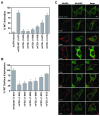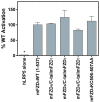Frizzled-4 C-terminus Distal to KTXXXW Motif is Essential for Normal Dishevelled Recruitment and Norrin-stimulated Activation of Lef/Tcf-dependent Transcriptional Activation
- PMID: 27096005
- PMCID: PMC4834752
- DOI: 10.5334/1750-2187-11-1
Frizzled-4 C-terminus Distal to KTXXXW Motif is Essential for Normal Dishevelled Recruitment and Norrin-stimulated Activation of Lef/Tcf-dependent Transcriptional Activation
Abstract
The carboxy (C)-termini of G protein coupled receptors (GPCR) dictate essential functions. The KTXXXW motif C-terminus of Frizzleds (FZD) has been implicated in recruitment of Dishevelled (DVL). Through study of FZD4 and its associated ligand Norrin, we report that a minimum of three residues distal to the KTXXXW motif in the C-terminal tail of Frizzled-4 are essential for DVL recruitment and robust Lef/Tcf-dependent transcriptional activation in response to Norrin.
Keywords: Dishevelled; Frizzled; Frizzled-4; Norrin; carboxy-terminus; helix VIII.
Figures



Similar articles
-
Biophysical and functional characterization of Norrin signaling through Frizzled4.Proc Natl Acad Sci U S A. 2018 Aug 28;115(35):8787-8792. doi: 10.1073/pnas.1805901115. Epub 2018 Aug 13. Proc Natl Acad Sci U S A. 2018. PMID: 30104375 Free PMC article.
-
The Intracellular Loop 2 F328S Frizzled-4 Mutation Implicated in Familial Exudative Vitreoretinopathy Impairs Dishevelled Recruitment.J Mol Signal. 2015 Nov 24;10:5. doi: 10.5334/1750-2187-10-6. J Mol Signal. 2015. PMID: 27096003 Free PMC article.
-
The co-receptor Tetraspanin12 directly captures Norrin to promote ligand-specific β-catenin signaling.bioRxiv [Preprint]. 2024 Nov 20:2024.02.03.578714. doi: 10.1101/2024.02.03.578714. bioRxiv. 2024. Update in: Elife. 2025 Jan 02;13:RP96743. doi: 10.7554/eLife.96743. PMID: 38352533 Free PMC article. Updated. Preprint.
-
The Frizzled family of unconventional G-protein-coupled receptors.Trends Pharmacol Sci. 2007 Oct;28(10):518-25. doi: 10.1016/j.tips.2007.09.001. Epub 2007 Sep 19. Trends Pharmacol Sci. 2007. PMID: 17884187 Review.
-
Frizzleds: new members of the superfamily of G-protein-coupled receptors.Front Biosci. 2004 May 1;9:1048-58. doi: 10.2741/1308. Front Biosci. 2004. PMID: 14977528 Review.
Cited by
-
Biophysical and functional characterization of Norrin signaling through Frizzled4.Proc Natl Acad Sci U S A. 2018 Aug 28;115(35):8787-8792. doi: 10.1073/pnas.1805901115. Epub 2018 Aug 13. Proc Natl Acad Sci U S A. 2018. PMID: 30104375 Free PMC article.
-
Functional dissection of the N-terminal extracellular domains of Frizzled 6 reveals their roles for receptor localization and Dishevelled recruitment.J Biol Chem. 2018 Nov 16;293(46):17875-17887. doi: 10.1074/jbc.RA118.004763. Epub 2018 Sep 20. J Biol Chem. 2018. PMID: 30237173 Free PMC article.
-
Structure-based prediction of Wnt binding affinities for Frizzled-type cysteine-rich domains.J Biol Chem. 2017 Jul 7;292(27):11218-11229. doi: 10.1074/jbc.M117.786269. Epub 2017 May 22. J Biol Chem. 2017. PMID: 28533339 Free PMC article.
-
Familial Exudative Vitreoretinopathy-Related Disease-Causing Genes and Norrin/β-Catenin Signal Pathway: Structure, Function, and Mutation Spectrums.J Ophthalmol. 2019 Nov 16;2019:5782536. doi: 10.1155/2019/5782536. eCollection 2019. J Ophthalmol. 2019. PMID: 31827910 Free PMC article. Review.
References
-
- Bockaert J, Marin P, Dumuis A, Fagni L. The ‘magic tail’ of G protein-coupled receptors: an anchorage for functional protein networks. FEBS Lett. 2003;546(1):65–72. doi: 10.1016/S0014-5793(03)00453-8. Available at http://www.ncbi.nlm.nih.gov/pubmed/12829238 . - DOI - PubMed
-
- Nie J, Lewis DL. The proximal and distal C-terminal tail domains of the CB1 cannabinoid receptor mediate G protein coupling. Neuroscience. 2001;107(1):161–167. doi: 10.1016/S0306-4522(01)00335-9. Available at http://www.ncbi.nlm.nih.gov/pubmed/11744255 . - DOI - PubMed
Grants and funding
LinkOut - more resources
Full Text Sources
Other Literature Sources

